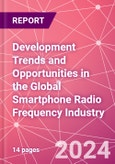The global mobile communication radio frequency (RF) market has undergone significant changes with the advent of 5G communication. Qualcomm's introduction of a comprehensive solution from baseband to antenna has gradually positioned it alongside other traditional RF giants. Furthermore, in response to the escalation of the China-US trade war, China actively promotes local production capacity, achieving supply chain autonomy.
Chinese RF manufacturers, riding on the growth of 5G communication and support from domestic smartphone manufacturers, are gradually achieving localization. This, however, presents a potential key factor hindering the development of leading RF companies.
This product will be delivered within 3-5 business days.
Table of Contents
Companies Mentioned (Partial List)
A selection of companies mentioned in this report includes, but is not limited to:
- Advanced Wireless Semiconductor
- Apple
- Broadcom
- Cavendish Kinetics
- Hisilicon
- Honor
- Huawei
- Inari
- Infineon
- Intel
- Lansus Technologies
- Marvell
- Maxscend Technologies
- MediaTek
- Microgate Technology
- Motorola
- Murata
- Nvidia
- Onmicro Electronics
- Oppo
- Qorvo
- Qualcomm
- Samsung
- Skyworks
- Smarter Microelectronics
- SMIC
- Transcom
- Unisoc
- Vanchip Tech
- Vivo
- WIN Semiconductors
- Xiaomi
Methodology
Primary research with a holistic, cross-domain approach
The exhaustive primary research methods are central to the value that the analyst delivers. A combination of questionnaires and on-site visits to the major manufacturers provides a first view of the latest data and trends. Information is subsequently validated by interviews with the manufacturers' suppliers and customers, covering a holistic industry value chain. This process is backed up by a cross-domain team-based approach, creating an interlaced network across numerous interrelated components and system-level devices to ensure statistical integrity and provide in-depth insight.
Complementing primary research is a running database and secondary research of industry and market information. Dedicated research into the macro-environmental trends shaping the ICT industry also allows the analyst to forecast future development trends and generate foresight perspectives. With more than 20 years of experience and endeavors in research, the methods and methodologies include:
Method
- Component supplier interviews
- System supplier interviews
- User interviews
- Channel interviews
- IPO interviews
- Focus groups
- Consumer surveys
- Production databases
- Financial data
- Custom databases
Methodology
- Technology forecasting and assessment
- Product assessment and selection
- Product life cycles
- Added value analysis
- Market trends
- Scenario analysis
- Competitor analysis

LOADING...








